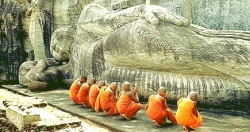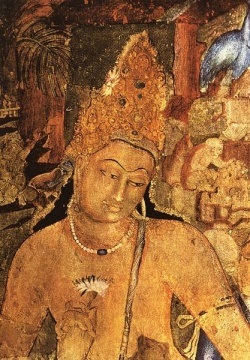Shakyamuni's Teachings
After his awakening, Buddha Shakyamuni spent the next seven weeks quietly digesting what had happened. His initial assessment was that no one else could possibly understand what he had discovered. Eventually, however, the Buddha decided he had a responsibility to try to communicate his understanding to others. He set off for Benares, a major city a few miles away.
When we see how things actually are, our whole system experiences a profound shock. We are not what we thought we were. All our struggles to define who and what we are are revealed as pointless, fruitless, and self-defeating. At first, we have no idea what to do or how to function, but we are still breathing. Life goes on, but now what? Our natural human impulse is to share our knowledge and understanding with others. This impulse manifests in life as compassion, which is a response to the circumstances of the moment.
In the village of Sarnath, a suburb of Benares, Buddha encountered his companions in asceticism. At first, they didn’t want to have anything to do with him and resolved to ignore him. As Buddha approached, however, they felt an extraordinary presence and spontaneously rose to greet him. They were so awed by his presence that they asked him to explain what had happened. Buddha Shakyamuni started with the existence of suffering and explained what he now knew.
For Buddha, the circumstance of the moment was this chance meeting with his former companions. All of them had been motivated originally by the question of suffering, so he gave his first teaching, the four noble truths.
The Four Noble Truths
Buddha Shakyamuni’s way to presence was through the question of suffering. What is it? How does it arise? Can it be ended? How do we end it? When other spiritual teachers and philosophers asked Buddha Shakyamuni to describe his teaching, he usually answered, “I teach one thing and one thing only, suffering and the end of suffering.” In his first teaching, he formulated his understanding as the four noble truths:
Suffering
The origin of suffering
The cessation of suffering
The path to cessation
Stated baldly, the four truths seem a bit enigmatic. They are, in fact, based on a simple problem-solving model, a model that dates far back in Indian philosophy and medicine.
What is the problem?
What is the root of the problem?
Is there a solution?
How do you put the solution into effect?
Suffering
The first noble truth is the truth of suffering: there is suffering. Suffering is the central problem of human experience. Buddha did not ignore suffering or try to explain it away as an unfortunate side effect of a divine plan or cosmic order. Suffering was, for him, the central issue.
And it is still the central issue for us today. So, what is suffering? The Sanskrit term is dukkha, a term that refers to the unsatisfying quality of experience. It is a general term that covers everything from vague feelings of unease to extreme physical and emotional anguish. Suffering, as it is used in the first noble truth, refers to any sense of discomfort. We all experience discomfort, whether it is the slight uneasiness of embarrassment or the intense pain of bone cancer. When discomfort arises, our first impulse is to put an end to it, to stop it any way that we can. We are, in effect, trying to separate ourselves from what we are experiencing and, by doing so, separating ourselves from life and from the mystery of being. The first noble truth is basically an injunction not to ignore or dismiss what we experience.
The first noble truth says that suffering is pervasive. It invites us not to ignore or avoid it, but to look at it, know what it is, and understand how it arises.
Creating Suffering
Buddha Shakyamuni’s second insight involves the origin of suffering. Suffering comes from emotional reactivity.
All experience is pleasant, unpleasant, or neutral. The three fundamental emotional reactions to experience are attraction, aversion, and dullness or indifference. Attraction is the emotional reaction to what is pleasant. Aversion is the reaction to what is unpleasant. Indifference is the reaction to what is neutral. The three reactions are called the three poisons because they poison our experience of life. They are often symbolized in Buddhist iconography as a rooster, a snake and a pig.
The second noble truth tells us that the origin of suffering is emotional reactivity. What do we do to end this suffering? We dismantle the patterns of emotional reactivity.
“Everything that the human race has done and thought is concerned with the assuagement of pain. One has to keep this in mind if one wishes to understand spiritual movements and their development.”
— Albert Einstein
Ending Suffering
Is it possible to disengage from reactivity? The third noble truth is Shakyamuni’s powerful answer, yes. He saw that the sense of self, of “I,” is the basis of emotional reaction, and that “I” as a real entity doesn’t exist. In other words, when the conditioning that underlies the sense of separation, the false duality of subject and object, is dismantled, suffering ceases.
“It doesn’t exist: even buddhas do not see it.
It doesn’t not exist: it is the source of all experience.
This isn’t a contradiction: this is the middle way!
May I know the pure being of mind, free from any definition.”
— Rangjung Dorje
We cannot and do not end pain, but we can and do end suffering. We end suffering by ceasing to identify with what we are not: a pattern that interprets experience as separate and other and then strives to justify its own imagined existence.
In the account of Buddha’s awakening, Mara, the demon of obsession, and his army represent patterns and conditioning. Buddha Shakyamuni rested in attention, undistracted and undisturbed by the ploys and attacks of Mara. His attention penetrated Mara and his army, so that he saw them and experienced them for what they are: movements in mind. They fell apart and ceased to function. The fetters of conditioning fell away. All that remained was original mind, pristine awareness. When Mara, the sense of “I,” demanded an external authority for pristine awareness and direct experience, Buddha knew none was necessary, so he simply touched the earth, saying, in effect, “Here’s your authority. That’s it.”
Buddha Shakyamuni could say unequivocally that there is an end to suffering because he developed such a high level of attention, diamond-like attention, that he could rest in the mystery of being, the experience of not existing as a separate entity, with no fear and in complete clarity. At that level of attention, the experience of not existing as a separate entity is known for what it is and ceases to be a basis for fear and emotional reactivity. The key effort in the third noble truth is to come to this understanding ourselves. Suffering ends when we have sufficient ability in attention to be present in all experience — even the experience of not being a separate entity.
The Path
In the fourth noble truth, we are introduced to the path, the way of life, that leads to freedom from suffering and the reactive patterns that generate it.
Reactive patterns have been in place for a long time. Much of life is the product of their operation. To dismantle these patterns we must take apart our lives. Attention works to dismantle patterns the way the energy of the sun melts ice. The directed energy of attention dissolves the structure of patterns, releasing the energy locked in them. We experience the freed energy as awareness and presence.
To cultivate and apply attention, we travel the eightfold path: right speech, right action, right livelihood, right effort, right mindfulness, right attention, right view, and right cognition.
In the context of the eightfold path, “right” does not mean right as opposed to wrong. The path is not a prescription for behavior that is deemed “right” by any authority. An action is right, in terms of the eightfold path, when the action comes from attention and presence rather than from reaction.
Walking the Path
How, for instance, do we practice right speech? Right speech does not mean saying “the right thing.” Ideas about the “right” thing usually come from conditioning. As a teacher, I field a lot of questions from students about different aspects of practice. Many are repetitive. I can easily fall into the habit of giving stock answers. If I give a stock answer, however, I am operating out of habituation, not presence. I am not really paying attention to the student, how he or she is asking the question, or how the question arises in the context of the student’s practice. A stock answer is not the practice of right speech, even though the answer may be “right” in a technical sense.
To cultivate right speech, listen as you talk so that you hear, with your own ears, exactly what you say and how you say it.
To travel the eightfold path, we make the same effort in each of eight areas. In addition to bringing attention to how we speak, we bring attention to how we act and behave, to what we do for a living, to the way we direct our efforts in practice and in life, to how we practice mindfulness and cultivate attention, and to how we look at the world and how we think.
The Three Disciplines
Fundamentally Buddhism is not a system of beliefs; instead, it is a set of instructions for entering the mystery of being. In the Buddha’s original formulation, these instructions are the eightfold path. The three disciplines — morality, meditation, and wisdom — show how the different elements of the eightfold path interact and provide a clear view of the key elements of practice.
“Prudent, cautious self-control
Is wisdom’s root.”
— Robert Burns
The first three elements — right speech, right action, and right livelihood — constitute the discipline of morality. The practice of morality has two aspects. First, by bringing attention to the ways in which we speak, act, and live, we create the conditions needed in order to practice. Second, the way we live is the expression of what we understand through practice. Therefore, in Buddhism, morality is not a matter of observing rigid moral principles, but of giving expression to the wisdom of original mind.
Right effort, right mindfulness, and right attention constitute the discipline of meditation. In this context, meditation actually means stable attention. We begin with the effort of resting with the breath. We develop mindfulness first, then stable attention. Attention is the heart of Buddhist practice. Although we use formal meditation to cultivate attention, the real practice is to live in attention all the time.
The third discipline, wisdom or understanding, involves right cognition and right view. Right cognition means that we bring attention to the thinking process. We use cognitive processes to uncover and correct problems in our practice and in our lives. Right view is seeing things as they actually are. By bringing attention to how we see things, we step out of the projected “realities” of conditioning.



